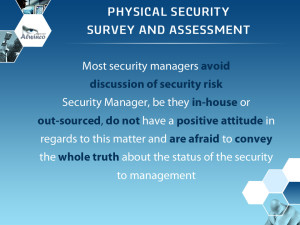There is often a reluctantly on behalf of the experienced Security Manager to call upon the services of the independent Security Risk Assessor. Reasons may include the fact that the Security Manager may feel he is placing his job in jeopardy because the board may view him as incompetent or that the company has simply not allocated sufficient funds in regards to security, but to name a few. The role of the independent consultant also remains largely misunderstood.
What is not realized is that the Security Consultant is actually an ally to the Security Manager. Often when the Security Manager presents a problem to the board alone, the situation is not fully acknowledged or realized, but if the same information is provided by the Security Risk Assessor, as a professional and external source, the board understands the problem and is more likely to allocate the necessary funds required for the solution. Furthermore the detailed Security Risk Assessment report supports better budget planning in regards to security and the expenditure of the company becomes more stabilized as unnecessary costs will be eliminated.
The Security Risk Assessor is also in the best possible position to reveal the true status of the company’s security. As an outsider, the Security Consultant can provide an unbiased and accurate view without the fear of stepping on someone’s toes. Often the Security Manager may feel that he cannot reveal the full reality of the situation or company losses as it may place his position in the company in endangerment. It also needs to be noted that sometimes due to familiarity and close involvement with the company, that the Security Manager may not be able to see the source of the problem or may unintentionally overlook some important details. Again, the assessor can provide the Security Manager with a new perspective in regards to the company’s security and be able to recommend workable solutions to alleviate the problem.
The process of the Security Risk Assessment is complicated and intricate. There is no quick, checklist and security can by no means be based on guesswork. The first phase consists of a full, thorough investigation of the site from the outside in. Various layers are considered and inspected before the next phase can begin. All threats and weaknesses in the security status of the company is identified and revealed. Based on these findings and extensive, active research, the independent assessor will then begin to derive workable solutions based purely upon functionality and need within the individualistic and unique Security Plan. This information will greatly aid the Security Manager in his important and vital role within the company by allowing the value of security to be measured and communicated to the board of the company. Furthermore the Security Risk Assessment can be used by the Emergency & Disaster Management Coordinator in good and effective future planning.
